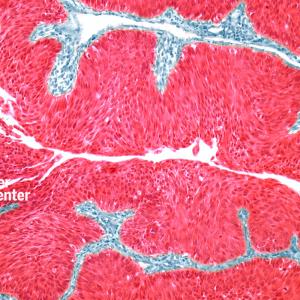
Scot Niglio, MD
While bladder cancer can affect people at any age, the disease mainly occurs in those who are older. For people with an aggressive form of bladder cancer, or those at high risk of the cancer recurring, a curative treatment is complete removal of the bladder, a procedure called radical cystectomy. Given the surgery’s high level of potential side effects and a mortality rate of around 7 percent, older patients might choose to forgo the procedure to avoid potential complications and the loss of bladder function.
Scot Niglio, MD, a medical oncologist at NYU Langone Health’s Perlmutter Cancer Center, is leading two clinical studies aimed at preserving the bladder in patients with bladder cancer whose disease is confined to the innermost layer of the bladder lining without invading the muscular wall (non-muscle-invasive bladder cancer, NMIBC) as well as a more aggressive form of the disease that has penetrated the muscular layer of the bladder wall (muscle-invasive bladder cancer, MIBC).
“No one wants their bladder taken out, so we are always trying to find ways to be able to preserve a bladder that still works for the patient while getting to a cure,” said Dr. Niglio, who also is an assistant professor in the Department of Medicine at NYU Grossman School of Medicine. “In these trials, we are trying to prevent a patient from ever having their bladder removed.”
Combining Pembrolizumab with Other Immune System Targets
The first trial, called KEYNOTE-057, is an expansion of a trial that led to the Food and Drug Administration’s approval of the immune checkpoint inhibitor pembrolizumab as a treatment for bacillus Calmette-Guérin (BCG)–unresponsive NMIBC. The results of that trial showed that pembrolizumab elicited a 41.2 percent complete response rate in patients after the initial four treatments, with half of those (20 percent) maintaining a complete response after a year of treatment.
The phase 2 trial that Dr. Niglio is leading at Perlmutter Cancer Center is evaluating two new investigational agents in combination with pembrolizumab. The first is vibostolimab, a monoclonal antibody that targets the protein TIGIT, which plays a role in suppressing the activity of the immune system’s cytotoxic T cells and natural killer cells. The other drug is the monoclonal antibody favezelimab, which targets LAG-3, a protein associated with T cell exhaustion in the tumor microenvironment that contributes to immune suppression.
“Both TIGIT and LAG-3 are immunomarkers that have been associated with the presence of bladder cancer and with a poor prognosis, respectively,” Dr. Niglio said. “Since both proteins are involved in immune suppression, it makes sense to combine antibodies targeting them with pembrolizumab in an attempt to avoid bladder removal.”
Combining Pembrolizumab with Chemoradiotherapy
The other trial that Dr. Niglio is leading, KEYNOTE-992, is evaluating whether adding pembrolizumab to low-dose chemotherapy and radiation (chemoradiotherapy) improves bladder preservation compared to chemoradiotherapy alone in people with muscle-invasive urothelial bladder cancer.
The use of chemoradiotherapy in cancer treatment is based on the rationale that the two treatments have synergistic effects, enhancing the overall effectiveness of the cancer treatment. In this phase 3 study, participants will be randomly assigned to receive either chemoradiotherapy alone or chemoradiotherapy combined with pembrolizumab.
“With KEYNOTE-992, we are looking at ways to preserve the bladder in more patients that have localized bladder cancer that invades the muscle,” Dr. Niglio said.
“For people with NMIBC or MIBC who are interested in preserving bladder function, both of these studies are great trials to look into,” Dr. Niglio continued.

